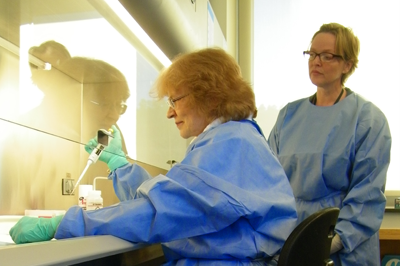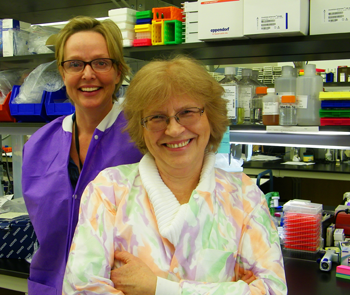Tried-and-true and State-of-the-art Combine to Uncover a Hidden Virus

Scientists Olga Kosoy, MS (L) and Amy Lambert, PhD (R) discover an unexpected virus while researching Heartland virus at CDC’s Fort Collins, Colorado virology laboratory.
Imagine doing your routine work and making an amazing discovery. That’s exactly what happened to CDC scientists studying a tick-associated disease.
While doing routine virus isolation from a blood sample collected from a patient enrolled in a study of Heartland virus, a recently discovered tick-associated virus, CDC microbiologist Olga Kosoy’s keen eye saw something unexpected: evidence of another virus. Because it seemed completely different, she asked CDC scientist Amy Lambert to sequence the virus genome using the powerful tools of Advanced Molecular Detection (AMD). Both were surprised to find that they had discovered an entirely new human pathogen.
Using classical and state-of-the art AMD techniques, the two had identified the virus as a member of the Thogotovirus genus. It is the first virus in this genus known to cause human disease in the Western hemisphere. Named after the county in Kansas where it was collected, Bourbon virus is suspected to be transmitted by ticks, as are many other Thogotoviruses.

Microbiologists Amy Lambert, PhD (L) and Olga Kosoy, MS (R) research tick- and mosquito-associated viruses in CDC’s Division of Vector-Borne Diseases.
“We have an unprecedented opportunity to help identify the public health burden of previously unknown and undetectable agents using AMD technologies; it’s an exciting time to be involved in this research,” said Amy Lambert, a virologist in CDC’s Division of Vector-Borne Diseases. Dr. Lambert emphasized, however, that the value of AMD technology was fully realized only because careful, classical epidemiology had identified the patient and careful, classical lab virology had exposed the presence of an unexpected virus. The new doesn’t replace the old; instead it adds depth and power.
There is no known treatment or vaccine for Bourbon virus disease and it is not yet known if it is transmitted by ticks. CDC scientists plan to continue using the full array of tools of epidemiology, entomology, and virology to learn more about Bourbon virus, how and where it is transmitted, and its risk to humans.
- Page last reviewed: August 17, 2015
- Page last updated: August 17, 2015
- Content source:
- Centers for Disease Control and Prevention
- Page maintained by: Office of Associate Director of Communication, Division of Public Affairs


 ShareCompartir
ShareCompartir